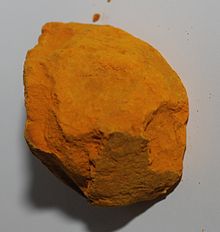| Indian yellow | |
|---|---|
 Indian yellow, historical dye collection of the Technical University of Dresden, Germany | |
| Hex triplet | #E3A857 |
| sRGBB (r, g, b) | (227, 168, 87) |
| HSV (h, s, v) | (35°, 62%, 89%) |
| CIELChuv (L, C, h) | (73, 73, 50°) |
| Source | The Mother of All HTML Colo(u)r Charts |
| ISCC–NBS descriptor | Moderate orange yellow |
| B: Normalized to [0–255] (byte) | |
Indian yellow is a complex pigment consisting primarily of euxanthic acid salts (magnesium euxanthate and calcium euxanthate),[1] euxanthone and sulphonated euxanthone.[2] It is also known as purree, snowshoe yellow, gaugoli, gogili, Hardwari peori, Monghyr puri, peoli, peori, peri rung, pioury, piuri, purrea arabica, pwree, jaune indien (French, Dutch), Indischgelb (German), yìndù huáng (Chinese), giallo indiano (Italian), amarillo indio (Spanish).[3]
The crystalline form dissolved in water or mixed with oil to produce a transparent yellow paint which was used in Indian frescoes, oil painting and watercolors. After application Indian yellow produced a clear, deep and luminescent orange-yellow color which, due to its fluorescence, appears especially vibrant and bright in sunlight. It was said to be of a disagreeable odour.[4] It was most used in India in the Mughal period and in Europe in the nineteenth century, before becoming commercially unavailable circa 1921.[5]
The origin and manufacture of Indian yellow had long been disputed partly due to variations among the sources themselves which included both pure materials and mixtures of chrome salts, dyes of plant origin and those of animal origin. Studies in 2018 of a sample collected by T. N. Mukharji in 1883 give credibility to his observations that it was obtained from concentrated urine from cows fed on a diet of mango leaves.[6][7]
- ^ Nicholas Eastaugh; Valentine Walsh; Tracey Chaplin; Ruth Siddall (2004). The pigment compendium : a dictionary of historical pigments. Elsevier Butterworth-Heinemann. p. 193. ISBN 978-0750657495. OCLC 56444720 – via Google Books.
- ^ Martin de Fonjaudran, Charlotte; Acocella, Angela; Accorsi, Gianluca; Tamburini, Diego; Verri, Giovanni; Rava, Amarilli; Whittaker, Samuel; Zerbetto, Francesco; Saunders, David (2017). "Optical and theoretical investigation of Indian yellow (euxanthic acid and euxanthone)" (PDF). Dyes and Pigments. 144: 234–241. doi:10.1016/j.dyepig.2017.05.034. ISSN 0143-7208.
- ^ "Indian yellow". www.getty.edu. Getty Art & Architecture Thesaurus. Retrieved 2018-07-17.
- ^ Hepworth, Harry (1924). Chemical Synthesis. Studies in the Investigation of Natural Organic Products. Blackie and Son. p. 25.
- ^ Cite error: The named reference
National Gallery of Art-1986was invoked but never defined (see the help page). - ^ Ploeger, Rebecca; Shugar, Aaron (2017). "The story of Indian yellow – excreting a solution". Journal of Cultural Heritage. 24: 197–205. doi:10.1016/j.culher.2016.12.001. ISSN 1296-2074.
- ^ Bailkin, Jordanna (2005). "Indian Yellow. Making and Breaking the Imperial Palette". Journal of Material Culture. 10 (2): 197–214. doi:10.1177/1359183505053075. ISSN 1359-1835. S2CID 143846855.